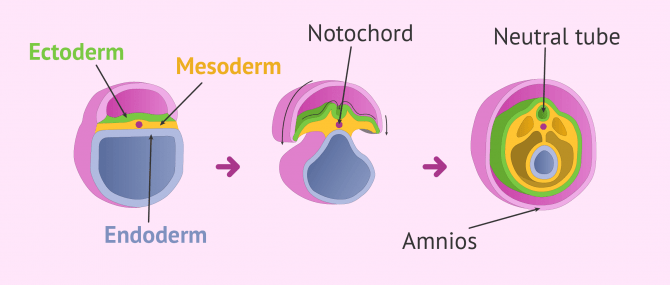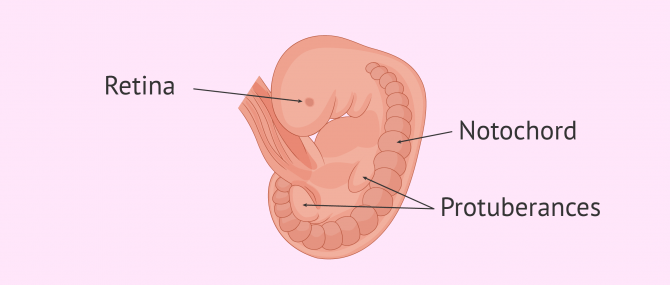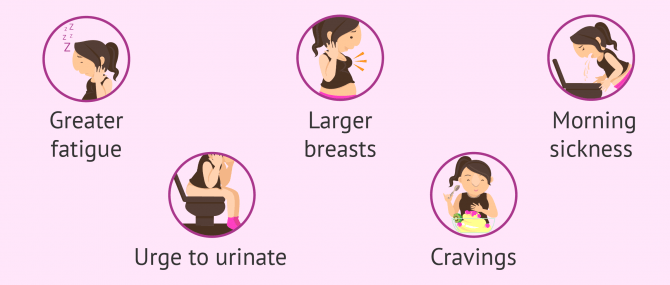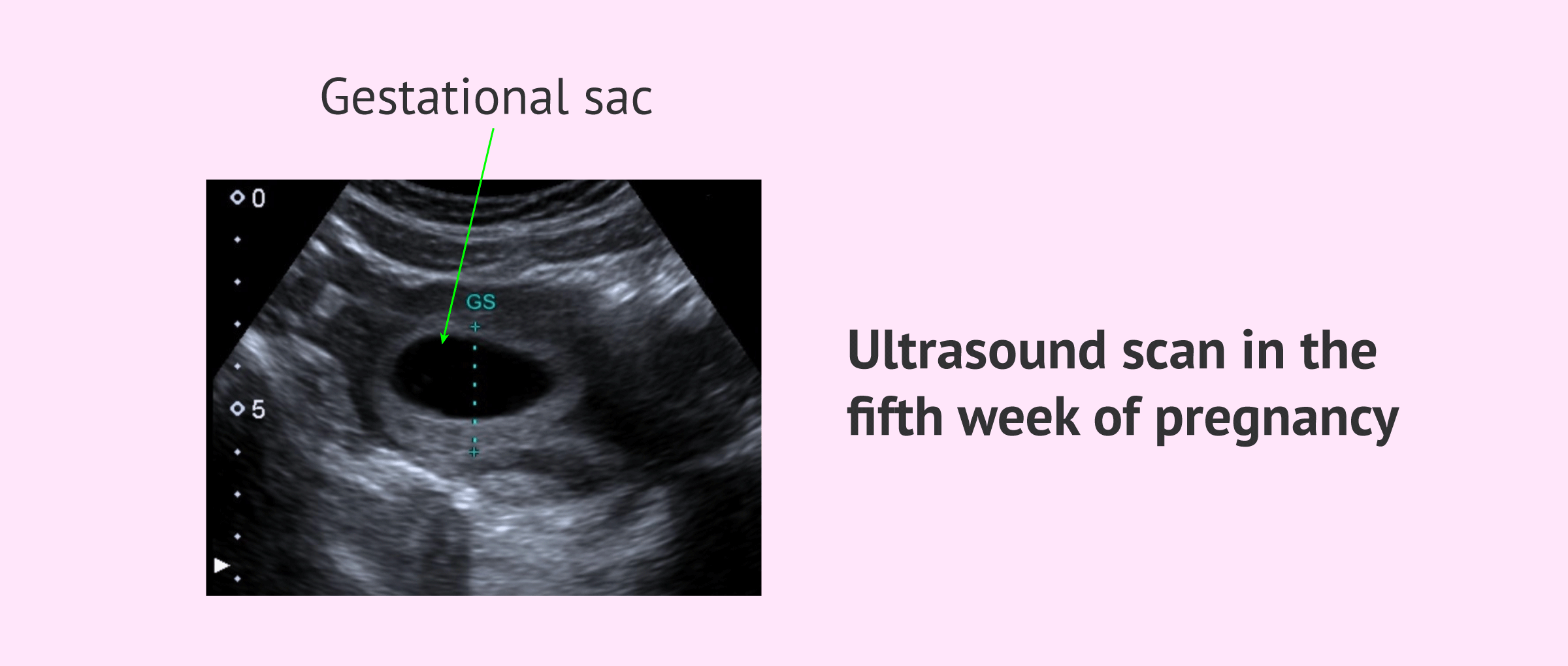In the fifth week of pregnancy the second month of gestation begins and both the mother and the baby begin to suffer great changes.
At this stage, the symptoms of pregnancy in women, such as morning sickness or tiredness, also become more evident.
Besides, the embryo increases the secretion of the beta-hCG hormone, which makes the pregnancy test undoubtedly positive. However, in this week of pregnancy it is not advisable to do an ultrasound since only the gestational sac can be seen, but not the embryo or hear its heartbeat.
Provided below is an index with the 8 points we are going to expand on in this article.
- 1.
- 1.1.
- 2.
- 3.
- 4.
- 5.
- 5.1.
- 5.2.
- 5.3.
- 5.4.
- 5.5.
- 6.
- 7.
- 8.
Embryonic development
By the fifth week of pregnancy, 3 weeks have passed since fertilization. Therefore, the embryo has exactly 3 weeks of embryonic development and is now beginning to divide itself.
Once the embryo has implanted in the maternal uterus, gastrulation takes place: the migration and movement of the cells of the bilaminal germinative disc of the embryo to form the three primordial embryonic layers, from which all the tissues of the future baby will be generated.
These three embryonic layers are known as the trilaminar germinative disc and are described below:
- Ectoderm
- external layer that originates from the epiblasts. From it the nervous system, the skin, the mouth and the outermost part of the body will be formed.
- Mesoderm
- intermediate layer that originates from the epiblasts. It will develop into muscles, skeleton and form the circulatory system with all the veins and arteries that forms it. It also leads to the reproductive and excretory system.
- Endoderm
- internal layer that will develop in most of the baby's organs: the lungs and all organs of the digestive system such as the stomach, intestine, etc.
In the following article you can find more detailed information about this: Gastrulation.
Embryo size in the fifth week of pregnancy
During the fifth week of pregnancy after gastrulation, the embryo still has a very small size, between 1 and 2 mm, and takes on the shape of a kidney bean after the following stages:
- Mesoderm cells form notochord. This is a flexible structure that acts as a support for the embryo until its spine is formed.
- The ectoderm folds over to form the neural tube, from which the spinal cord and brain of the embryo will appear.
- The embryo takes on the shape of a tube with bulges at its ends. The larger lump will result in the baby's head and the smaller ones will result in the baby's extremities.
- The primitive heart begins to develop but does not yet have a heartbeat.
- Facial features begin to form and the nostrils and retinas of future eyes appear.
On the other hand, the placenta is forming to be able to transmit nutrients and oxygen to the future baby until birth. However, at this moment the embryo receives the nutritional contribution thanks to the yolk sac, an embryonic annex that will disappear as the placenta develops.
Changes in women´s bodies
As they enter fifth week, many women take notice of their pregnancy when delay in menstruation becomes evident. Additionally, their body starts to show small signs of changes and new sensations.
In the fifth week of natural gestation as well as in pregnancy achieved by in vitro fertilization (IVF), the most common symptoms in pregnancy are the following:
- Greater fatigue or slumber
- Great urges to urinate
- Larger breast size
- Nausea and morning sickness
- Oedema
- Lower abdominal pain
- Stronger odour perception
- Cravings
Some of these symptoms disappear by the end of the first trimester of pregnancy such as nausea, but this is not always the case. It is also important to know that not all women experience the same symptoms. In fact, some women say they have no symptoms during five weeks of pregnancy.
Ultrasound in the fifth week
As soon as the woman discovers she is pregnant, she should make an appointment with the gynaecologist for a first ultrasound.
The ultrasound that confirms the pregnancy should definitely be done from the 6th week of pregnancy. However, by week 5 it is already possible to visualize by ultrasound the gestational sac, a bag filled with amniotic fluid that surrounds the embryo.
Together with the beta-hCG test, the presence of the gestational sac confirms that there is an intrauterine pregnancy. This is especially important when the beta-hCG level is low, which may indicate a risk of ectopic pregnancy.
However, there is one drawback to doing the ultrasound at five weeks of pregnancy, as it is very likely that the gestational sac will be seen but not the embryo inside. This makes the gynaecologist suspicious of the possibility of an embryonic pregnancy.
With 5 weeks of pregnancy, sometimes it is possible by ultrasound to observe the gallbladder yolk inside the gestational sac. In doing so, it is confirmed that there is an embryo and that the gestation is evolving.
Assisted procreation, as any other medical treatment, requires that you rely on the professionalism of the doctors and staff of the clinic you choose. Obviously, each clinic is different. Get now your Fertility Report, which will select several clinics for you out of the pool of clinics that meet our strict quality criteria. Moreover, it will offer you a comparison between the fees and conditions each clinic offers in order for you to make a well informed choice.
If the embryo or gallbladder cannot be seen in the fifth week of pregnancy, the woman will have to repeat the ultrasound one or two weeks later, which makes her extremely anxious and worried. Therefore, it is not recommended to do the first ultrasound during the fifth week.
Finally, in an ultrasound during the fifth week it is not possible to detect the heartbeat of the embryo, since the primitive heart has not been developed yet. In this case, the expectant mother will have to wait until the 7th week of pregnancy.
Precautions for the fifth week
The care of the pregnant woman in the fifth week of gestation is the same as during the first month of pregnancy.
However, this fifth week of pregnancy is very special as the first organs of the future baby begin to form. Therefore, we are going to emphasize the most important recommendations:
- Have a healthy and balanced diet that provides the nutrients and vitamins necessary for embryonic development.
- Take folic acid to prevent the appearance of birth defects in the brain and spinal cord of the future baby.
- Adapt physical exercise: practice low-intensity sports such as pilates, yoga or swimming.
- Do not abandon physical activity completely. Sports routines help women improve muscle tone, strength, and endurance, which is beneficial throughout pregnancy and childbirth. Postpartum recovery will also be faster in women who are active.
- Avoid tobacco, alcohol, and coffee.
For more information and advice on pregnancy care, you can read on in the next post: Health in pregnancy.
FAQs from users
Is it normal to bleed in the fifth week of pregnancy?
Brown spotting or light bleeding in the fifth week of pregnancy can mean many things. Embryo implantation symptoms usually occur when four weeks pregnant. Therefore, further bleeding could mean that there is a risk of miscarriage. If there is heavy bleeding, like in menstruation, the expected mother may have suffered a biochemical pregnancy.
There are other reasons that cause bleeding during pregnancy, such as uterine hematomas.
We recommend reading on this subject in the next post: Bleeding During Pregnancy – What’s Normal & What’s Not?
I am 5 weeks pregnant and only the gestational sac can be seen by ultrasound. Is this normal?
Yes, it is not recommended to do an ultrasound scan in the fifth week of pregnancy because it is possible to see the gestational sac without an embryo. This is because the embryo is still very small and can lead to confusion. On the other hand, the empty gestational sac already makes one suspect that it may be an anembryonic pregnancy, known as a blighted ovum. The woman will have to repeat the ultrasound a few weeks later to check if there is any problem with the pregnancy.
Is it possible that the pregnancy test is negative at 5 weeks?
In the fifth week of pregnancy the embryo has already been implanted in the uterus. At this point, the embryo begins to secrete the hormone beta-hCG, known as the pregnancy hormone, which is the one detected in a pregnancy test. Therefore, if the woman is really pregnant, the test will be positive in the fifth week. However, there can always be failures and therefore it is recommended to repeat the test after a few days in case of doubt.
You can read more about this in the following link: Pregnancy Symptoms but Negative Test, What Else Could It Be?
Can alcohol be drunk in the fifth week of pregnancy?
It is not advisable to drink alcohol once it is known that there is a pregnancy, since it could have negative effects for both the mother and the baby.
It is advisable for pregnant women to avoid toxic habits during pregnancy, such as smoking, drinking alcohol or drinking large amounts of coffee daily, among others. In addition, it is advisable to follow a healthy and balanced diet so that no nutrient is lacking.
What are the normal beta hCG values at 5 weeks gestation?
In general, at 5 weeks gestation the range of normal values for hCG hormone is between 850-20800 mIU/ml.
The reason for such a wide range for normal hCG levels is that the hormone values are highly variable in each pregnancy. This also makes the particular value less important compared to the levels increasing at the expected rate (in an evolving pregnancy, hCG doubles every 2-3 days in the first trimester of pregnancy).
Suggested for you
If there is any doubt with the pregnancy test, the most recommended practice in the fifth week of pregnancy is to have a quantitative blood done to detect the beta-hCG hormone, since it is more sensitive than the urine test in the pharmacy. You can get more information on this topic at the following link: When to Do a Pregnancy Test? – How to Use, Results & Accuracy
With an ultrasound at 5 weeks, a woman may also discover that she has a twin pregnancy. If you want to know the types of multiple pregnancies and all the details of a twin pregnancy, we recommend you read the following article: Multiple Gestation.
During the next week of pregnancy, the woman will have the same symptoms as in week 5 and the fetus will continually increase in size. You can read more about this in the next post: The sixth week of pregnancy.
We make a great effort to provide you with the highest quality information.
🙏 Please share this article if you liked it. 💜💜 You help us continue!
References
FAQs from users: 'Is it normal to bleed in the fifth week of pregnancy?', 'I am 5 weeks pregnant and only the gestational sac can be seen by ultrasound. Is this normal?', 'Is it possible that the pregnancy test is negative at 5 weeks?', 'Can alcohol be drunk in the fifth week of pregnancy?' and 'What are the normal beta hCG values at 5 weeks gestation?'.
Authors and contributors









I’m pregnant but no appetite, is this normal? my best friend could eat a horse and I’m like nothing!! I already lost 6lb.